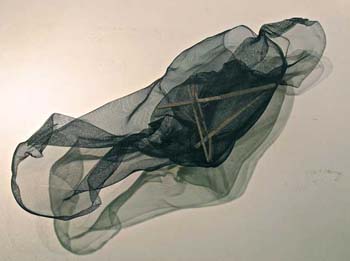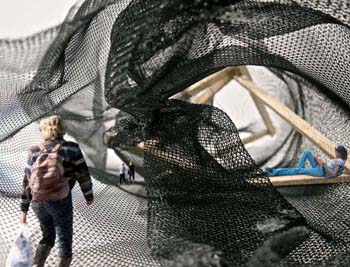Architecture Honors Project Fuses Theory and the Human Experience
In his first architecture class, the first semester of his sophomore year, Jarrett Ley '13 studied a "citizen architect" who lived in communities, got to know the people, and designed structures to meet their needs. Those ideas continue to resonate through Jarrett's architectural work.
In his words, "Architecture offers a conceptual framework to approach the world. I would argue that if architecture's intention is to do good, then it needs to start at a human level. As a designer I can't imbue any architectural construct beyond the meaning it has for me. But I can provide potential for allowing people to experience the space in a meaningful way."
In May Jarrett exhibited his Honors project, "Human Praxis: LGBTQ Homeless Youth Center," at Andrews Gallery. After an oral examination his thesis committee awarded him Highest Honors. The project conceives a transitional shelter and community center for lesbian, gay, bisexual, transgender, and queer homeless youth in Washington, D.C.
View a partial presentation of the project
 Jarrett's formal training
Jarrett's formal training  includes his W&M Art History major, an architecture program through Columbia University, and a semester of coursework in Rome with the Pratt Institute School of Architecture. Courses in the Department of
Art and Art History provided "a basic skills set" that allowed him to
articulate his ideas visually, and to be "productively critical" at
every stage of making. He credits a course in Methods of Art History with
helping him to become aware of the process and role of theory and his
relationship to his own agency and work.
includes his W&M Art History major, an architecture program through Columbia University, and a semester of coursework in Rome with the Pratt Institute School of Architecture. Courses in the Department of
Art and Art History provided "a basic skills set" that allowed him to
articulate his ideas visually, and to be "productively critical" at
every stage of making. He credits a course in Methods of Art History with
helping him to become aware of the process and role of theory and his
relationship to his own agency and work.
Still, he noted, "I had all these ideas that weren't necessarily anchored in real needs." And then that changed.
In the summer of 2012 Jarrett volunteered as a house monitor at the Wanda Alston House, a center for lesbian, gay, bisexual, transgender, and queer youth in Washington, D.C. Through inhabiting the social and spatial zones of the organization, he formulated the critical questions that he set out to resolve in his Honors project.
"I was designing for a group of individuals I knew and cared about. The specificity of my project’s human dimension provided meaningful and productive parameters in which to operate. It enabled me to honestly prioritize the residents’ needs when I faced the difficult questions posed in designing such a place."
Ultimately his project involved every facet of architectural design, from site selection to the intersections of public and private spaces to models and specifications of the built environment.
"I wanted the spaces to intentionally collide, to promote productive purposes and address exclusion. I became very interested in the fluid thresholds of spaces, ways to mitigate light quality and create semi-transparent walls."
While the project involved a great deal of research and conceptual imagining, for Jarrett it was the process of making the model that was most important. "Manipulating forms in three dimensions was like reconciling a language in my hands," he said. The model also helped him to explore circulation flows and provided a presentation tool for his ideas.
"I've been searching for answers about how architecture can do good, do better, serve the people who need it most. Through this project I engaged these questions and reconciled a lot of influences. I've begun to learn how I design."
In the coming year, Ley wants to work in the industry and gain practical experience. Then he plans to pursue a master's degree in architecture.
"I want to continue to develop my abilities, to evolve as a person who is committed to being honest and making contributions as an architect. "
And the future of Jarrett's proposed homeless shelter?
"At the very least, I hope my design provides a means to continue the dialogue in D.C. about a real need for the LGBTQ homeless youth."
 Skip to main content
Skip to main content
